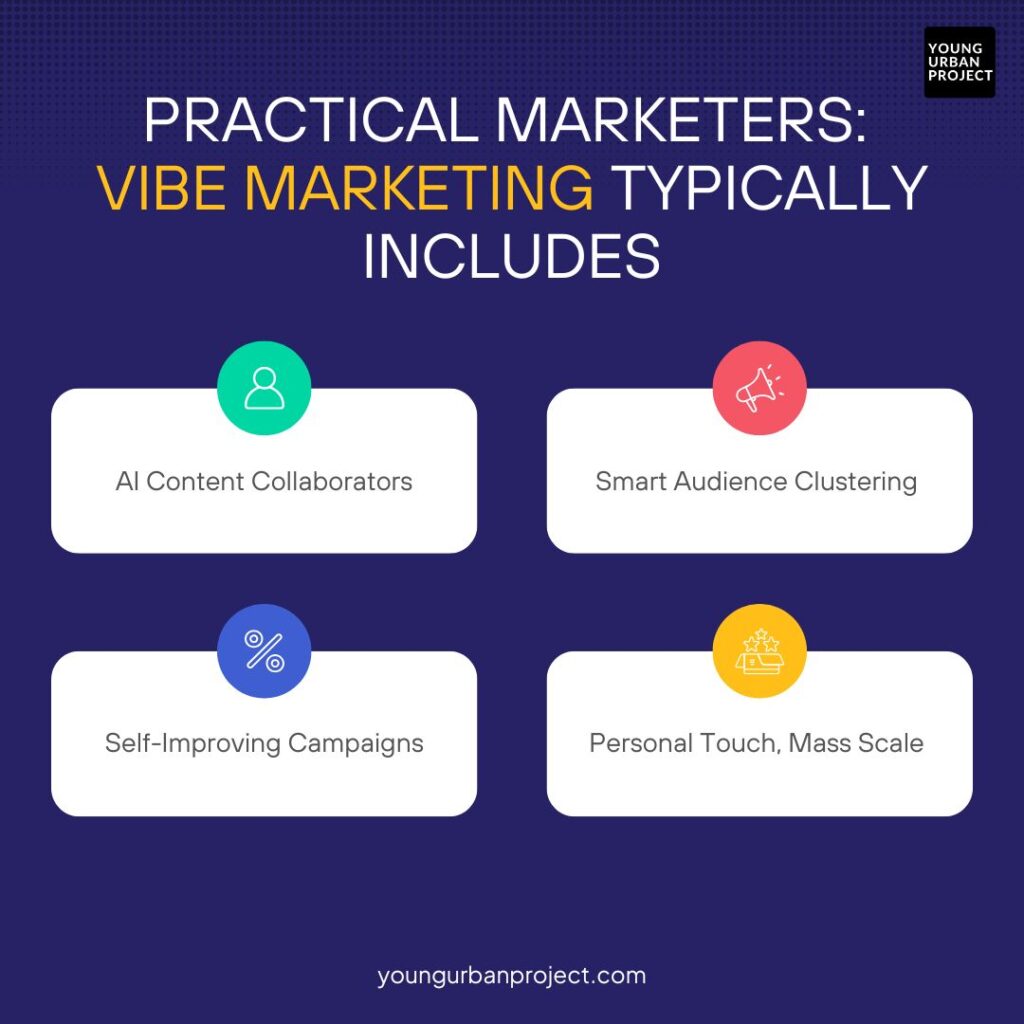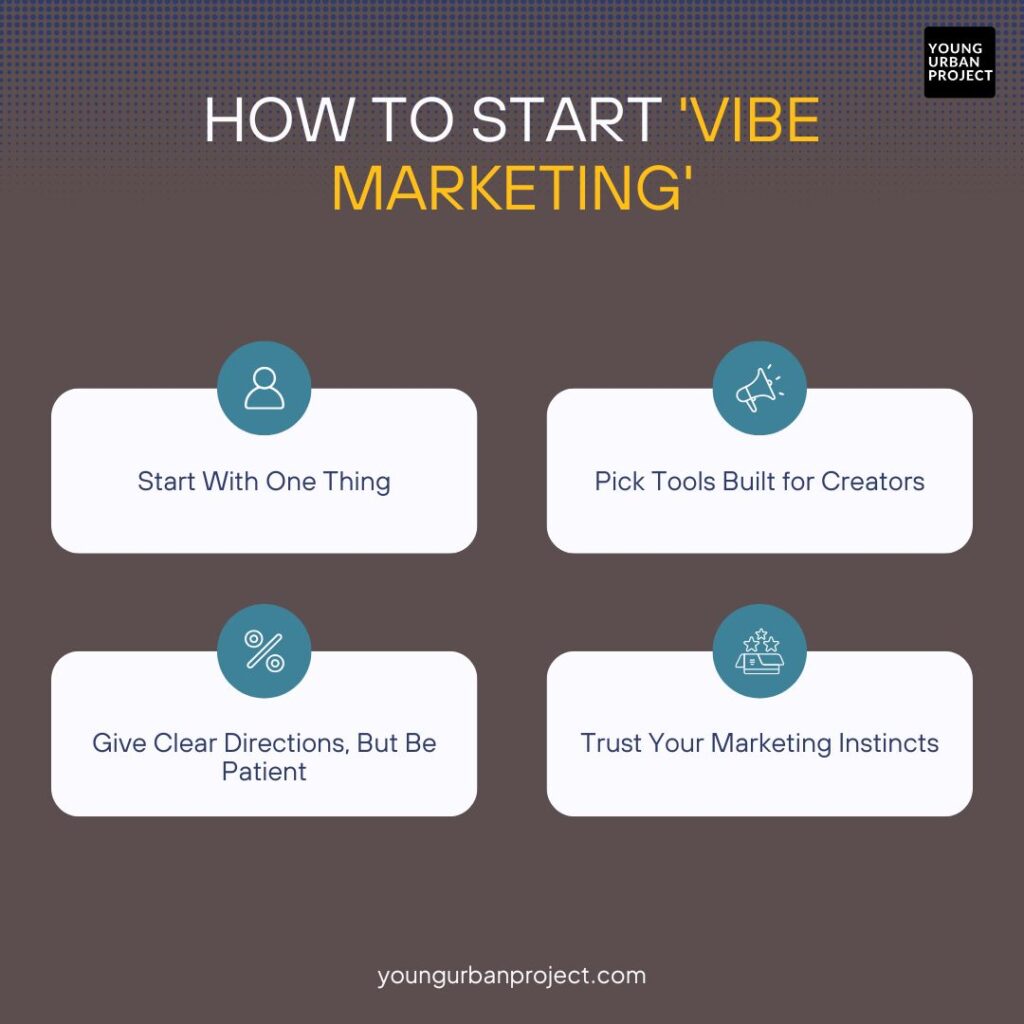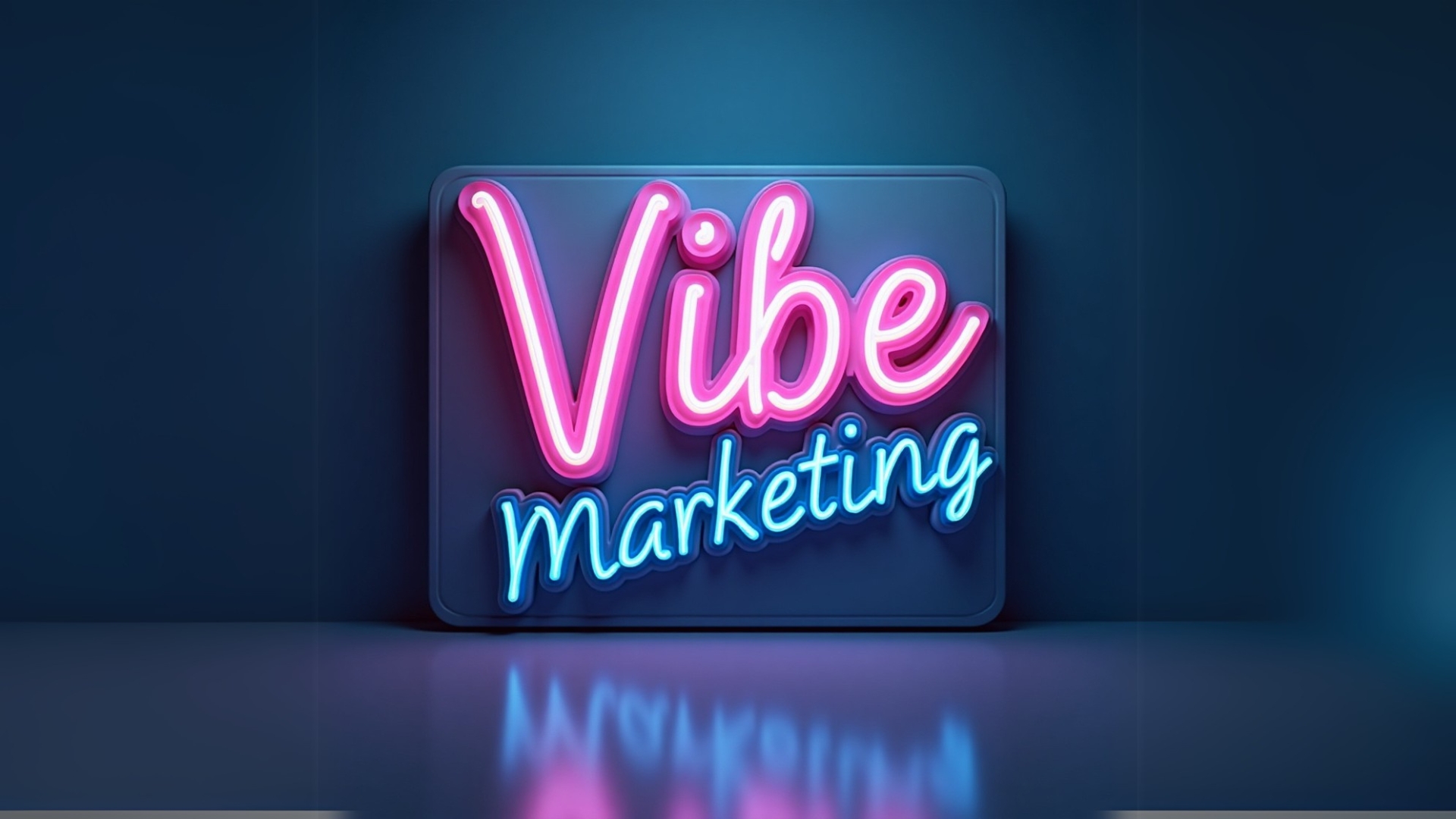You know that feeling when you hear a new term and think, “Oh great, what now?”
That was me when I first heard about Vibe Marketing.
Table of Contents
At first, I’ll admit, I rolled my eyes. It sounded like something straight out of a marketing guru’s LinkedIn post. But then, as I dug a little deeper (out of curiosity, or maybe stubbornness), I realized… this isn’t just another buzzword. It’s actually a subtle but powerful shift in how we, as marketers, are starting to work, especially with AI stepping into the picture.
So, if you’ve been wondering what Vibe Marketing really is, and whether it’s something you should care about, let’s unpack it together. No jargon. No fluff. Just a realistic take on what’s happening.
So, What is Vibe Marketing?
Here’s the simplest way I can put it:
Vibe Marketing is using AI to handle the execution side of marketing, so you, the human, can focus on setting the vibe.
But let’s not confuse this with “just automating tasks.” It’s more nuanced than that. Think of it like this: instead of spending hours writing ad copy, scheduling posts, or analyzing endless data sheets, you let AI do that groundwork. Meanwhile, you steer the creative direction, the brand voice, the emotional connection, basically, the stuff AI can’t truly replicate (yet).
It’s inspired by something called “vibe coding”, a term coined by OpenAI’s co-founder, Andrej Karpathy. In coding, it means giving AI a rough idea, and it fills in the technical blanks. In marketing, it’s pretty much the same, except instead of code, AI is drafting emails, segmenting audiences, or suggesting content ideas based on your prompts.
So yeah, Vibe Marketing is less about hard-selling and more about smart-operating.
Why is Everyone Suddenly Talking About Vibe Marketing?
Good question. I think part of the reason is… marketers are tired.
Let’s be honest, the digital world moves ridiculously fast. New platforms pop up, algorithms change overnight, and audiences expect hyper-personalized content 24/7. It’s exhausting to keep up manually.
That’s where Vibe Marketing comes in, not as a replacement for marketers, but as a relief. AI takes over the repetitive (and let’s face it, boring) stuff. You get to focus on what actually moves people: storytelling, creativity, understanding your audience’s mood — or should I say, their vibe.
And in 2025, where attention spans are shorter than ever, setting the right vibe isn’t optional. It’s survival.
Key Ingredients that Make Vibe Marketing Work

Before diving into tools, let’s explore the essential mindset shifts:
1. AI is Your Copilot, Not Captain
AI executes, you direct. While algorithms handle tasks, they can’t grasp cultural nuances or emotional context. You bring the human touch that connects with audiences authentically—your vision steers the ship while AI rows the boat.
2. Quick Beats Perfect
Embrace the messy middle. Vibe Marketing values speed and testing over polished perfection. Launch that 80% finished campaign now rather than the 100% perfect one next month. Real-world feedback trumps boardroom theories every time.
3. Heart Over Heatmaps
Data informs, but emotion converts. Charts tell you what happened; human insight explains why. People don’t buy because of statistics—they buy when something resonates. Use AI to gather insights, but let human instinct interpret the why.
For the Practical Marketers, Vibe Marketing Typically Includes:

1. AI Content Collaborators
From email sequences to social captions, AI tools draft your baseline content. You add the personality, punch, and perspective that no algorithm can replicate. Think of AI as your first-draft writer, not your creative director.
2. Smart Audience Clustering
Modern platforms spot patterns humans might miss. They group your audience based on subtle behaviors, not just demographics. This lets you speak directly to specific needs rather than broadcasting generic messages to everyone.
3. Self-Improving Campaigns
Today’s ad platforms optimize while you sleep, adjusting bids, placements, and creative elements based on performance. You set the boundaries and goals; the AI handles the constant tweaking that once consumed your days.
4. Personal touch, Mass Scale
Tailored messaging becomes possible beyond your team’s capacity. AI suggests variations based on user behavior, allowing intimate-feeling communication with thousands. You craft the voice; AI delivers it to the right person at the right moment.
A Quick Story
I came across this case study recently — Therese Waechter, who runs a small online sticker shop called Otto’s Grotto.
She wasn’t a tech wizard. In fact, she didn’t even like dealing with digital stuff.
But when she started using AI tools to write her product descriptions, generate hashtags, and even design parts of her Shopify store, her revenue didn’t just grow… it doubled. In a year.
That’s Vibe Marketing in action. She didn’t obsess over every little task. She let AI handle the “how,” while she focused on the “feel” of her brand.
(Source: Business Insider)
Is Vibe Marketing for Everyone?
Honestly? Maybe not.
If you’re someone who loves micromanaging every sentence or designing every pixel by hand, this approach might feel… uncomfortable. Letting AI take over parts of your workflow requires a bit of trust (and letting go of perfectionism).
But if you’re trying to scale, stay relevant, or just free up mental space, Vibe Marketing can be a game-changer.
That said, there are caveats.
Also Read: Best AI Writing Tools: Write Smarter, Not Harder
The Not-So-Glossy Side of Vibe Marketing
Let’s keep it real. AI has limits:
1. AI Stumbles Frequently
These tools make mistakes—sometimes embarrassing ones. You’ll spend time fixing weird phrasing, fact-checking claims, and steering content back on track. Consider yourself AI’s editor-in-chief, not just its audience. Human oversight remains non-negotiable.
2. The Generic Trap
Without your fingerprints, AI-generated content risks sounding like everyone else’s. That sameness can erode what makes your brand special. Your unique perspective and voice must regularly interrupt the algorithm, or customers will feel the difference.
3. Data Ethics Matter
Customer information flowing through AI tools raises serious privacy questions. Are you storing data properly? Getting proper consent? Following regulations? The convenience of AI doesn’t exempt you from protecting people’s information and trust.
So while Vibe Marketing saves time, it’s definitely not “set it and forget it.” Think of it as collaborative cooking—you’re still the chef, even with fancy kitchen gadgets.
Also Read: Types of Marketing to Promote Your Brand
How to Start ‘Vibe Marketing’ Without Overthinking It
Ready to dip your toes in? Here’s how:

1. Start With One Thing
Choose a single repetitive task that drains your creative energy. Maybe it’s writing rough drafts of your weekly newsletter or brainstorming social captions. Master that workflow before tackling another. Small wins build confidence.
2. Pick Tools Built for Creators
Skip general-purpose AI for marketing-specific platforms that understand creative briefs, brand voice, and campaign mechanics. Look for tools that speak your language and offer templates designed for marketing contexts.
3. Give Clear Directions, But Be Patient
Write detailed prompts explaining context, goals, and boundaries. Then be ready to refine. First drafts rarely nail it, but each revision teaches the AI your preferences. The magic happens in the back-and-forth.
4. Trust Your Marketing Instincts
Numbers and metrics matter, but your gut reaction counts too. If something feels off about AI-generated content, it probably is. Your experience and human judgment remain your strongest assets—algorithms can’t replace them.
So… is Vibe Marketing Just a Trend?
It might sound like a trend, but Vibe Marketing is more of a response to how our roles as marketers are evolving. It’s not about chasing the next shiny tactic — it’s about adjusting to a world where AI is everywhere and attention is scarce. Sure, the name might change (we love rebranding things), but the philosophy will stick: letting AI handle the execution so we can focus on connection. It’s not a gimmick — it’s a practical mindset shift. If you’re still clinging to old-school grind-it-out methods, you might miss what this new wave is actually offering: time, clarity, and creative space.
Also Read: The Future of Digital Marketing: Trends & Predictions
Final Thoughts: It’s Not About the AI, It’s About the Vibe
Here’s the thing: AI is just the assistant. The vibe? That’s all you. People don’t remember campaigns because they were technically perfect; they remember how those campaigns made them feel. That emotional pulse — the tone, the timing, the personality, that’s what Vibe Marketing is all about. It’s not about replacing you; it’s about freeing you to do what only humans can do: spark real connection. So when the to-do list feels endless, ask yourself, “Is this a task or a vibe?” Let AI handle the busywork. You focus on the brand magic. That’s where the real marketing lives.
Bonus: A Few AI Tools to Kickstart Your Vibe Marketing Journey
- Jasper — for content generation.
- SurferSEO — for AI-assisted SEO optimization.
- Copy.ai — for ad copy and emails.
- ChatGPT (of course!) — for brainstorming and drafts.
- Canva AI — for quick design tweaks.
(No affiliations here — just tools I think are worth exploring.)

Enroll Now: Generative AI for Marketing Workshop
FAQs: Vibe Marketing
1. What exactly is Vibe Marketing?
Vibe Marketing is about using AI to handle the repetitive stuff—like writing posts or sorting data—so you can focus on the creative side. It’s more about how your brand feels than what it says. You’re in charge of the mood; AI helps execute it.
2. How is Vibe Marketing different from traditional digital marketing?
Traditional digital marketing often focuses on channels and conversions. Vibe Marketing is softer—it’s about setting the emotional tone and letting AI support the process. It’s less “sell, sell, sell” and more about building connection through consistency and brand feel.
3. Do you need to be tech-savvy to start Vibe Marketing?
Not at all. Many AI tools today are super user-friendly. Even small business owners with no tech background are using them. Start small—automate one task, like caption writing or email subject lines, and build from there.
4. Can Vibe Marketing work for B2B brands?
Yes, 100%. B2B doesn’t mean boring. In fact, brands that show personality in the B2B space stand out more. Vibe Marketing helps you keep your messaging human and consistent, while AI handles the backend tasks.
5. Is AI good enough to create content on its own?
AI can get you started—drafts, ideas, outlines. But it still needs your voice. Think of it like a smart assistant, not a creative genius. You’ll still need to tweak and guide it to make sure the final content sounds right for your brand.

